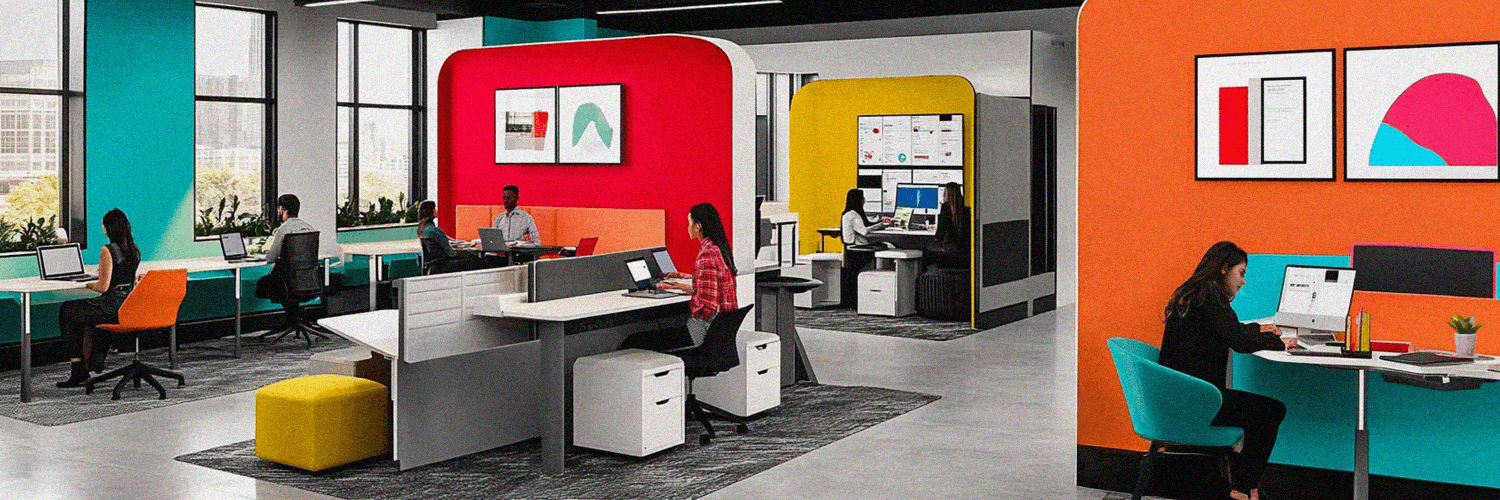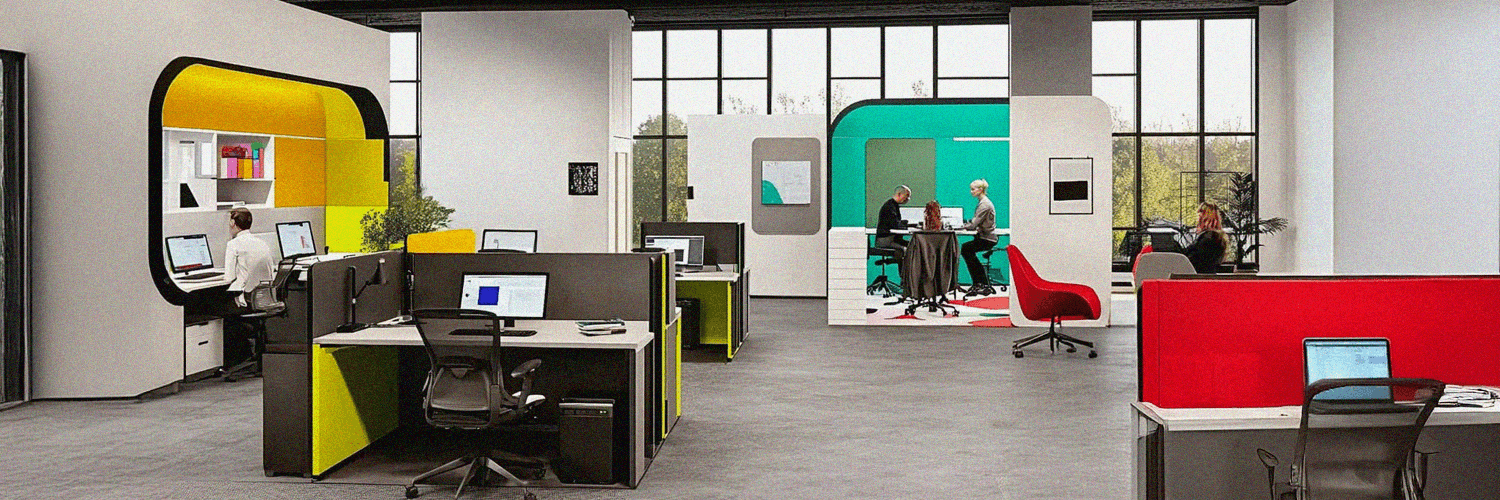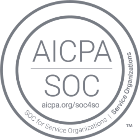Ever wondered how a simple change or a new idea can significantly alter the trajectory of a business? The transformative power of innovation in the workplace is undeniable, driving not just the development of groundbreaking products but also revolutionizing management practices, operational processes, and the very ethos that defines a company's culture.
According to recent research, companies with high employee engagement in innovation efforts are 21% more profitable and 17% more productive than their competitors. Despite this, a disconnect persists between intentions and outcomes: while innovation remains a priority for executives, many organizations struggle to translate this commitment into tangible results.
Our experience implementing workplace innovations across multiple industries has shown that success requires more than just creative ideas—it demands systematic approaches, cultural alignment, and measurable outcomes. Let's explore some of the most compelling instances of innovation in the workplace today!
TL;DR:
- Workplace innovation means using new ideas to improve how a company works, thinks, and grows.
- It includes changes to products, processes, team structures, marketing, and tech tools.
- Innovative companies are more profitable, productive, and adaptable than their competitors.
- Engaging employees in innovation boosts motivation, job satisfaction, and retention.
- Hybrid work models and flexible planning tools are modern examples of innovation in action.
- AI, automation, and employee-centered tech help streamline tasks and improve decision-making.
- Sustainable practices supported by data dashboards are gaining importance across industries.
- Innovation thrives with clear strategy, leadership support, and a culture that embraces change.
- Measuring success through both activity and impact metrics is essential for ongoing improvement.
- Every industry—from healthcare to finance—can benefit by tailoring innovation to its unique needs.
What Is Innovation in the Workplace?
Now, what exactly do we mean when we talk about innovation in the workplace? In short, workplace innovation is an umbrella term encompassing new methods and ideas to improve a company's operations, business model, or work culture. It focuses on making systems more efficient, enhancing service quality, or changing organizational hierarchies' structure.
Innovation always breaks the monotony and stirs up excitement. But more importantly—it unlocks immense potential for growth and improvement within organizations. The resulting transformation often leads businesses to either carve out new market niches or considerably enhance their footprint in existing market spaces.

Types of Workplace Innovation
Workplace innovation manifests in various forms, each addressing different aspects of an organization. Understanding these distinct types can help companies develop more targeted and effective innovation strategies:
Product Innovation
This involves creating new products or significantly improving existing ones to better meet customer needs or market demands. Product innovation often involves R&D departments but can be fueled by insights from any employee who interacts with customers or products.
Process Innovation
Process innovation focuses on improving how things get done within an organization. This might include streamlining workflows, automating repetitive tasks, or implementing new methodologies that enhance efficiency and reduce waste.
Organizational Innovation
This type refers to new ways of structuring work, distributing responsibilities, or making decisions. Examples include flattening hierarchies, implementing self-managing teams, or developing new approaches to leadership development.
Marketing Innovation
Marketing innovation involves new methods of promoting products or services, entering markets, or engaging with customers. This might include novel pricing strategies, distribution channels, or communication approaches.
According to a 2024 employee engagement report, only 46% of employees clearly know what is expected of them at work, down from 56% in 2020. This highlights the need for organizational innovation that clarifies roles and expectations in today's rapidly changing workplace.
The Importance of Workplace Innovation
Innovation is now a critical part of business strategy, not just a bonus. It goes beyond creating new products and includes fresh management, operations, and company culture approaches. All types of businesses, from startups to large corporations, benefit significantly from making innovation a daily practice.
How, more precisely?
The main reasons include growth and staying competitive. Innovative companies lead their industries by quickly adapting to market changes and focusing on customers. This adaptability keeps them ahead in a dynamic and competitive business world. In fact, digitally mature companies are 23% more profitable than their less mature peers.
Innovation in the workplace also improves problem-solving and decision-making. A culture of innovation allows employees to experiment and find unique solutions to challenges. This has a strategic impact on companies and helps attract and retain talented employees by providing a creatively stimulating work environment.
Recent data supports this perspective: According to a 2023 study, 75% of employers reported improvements in quality control, customer satisfaction, employee experience, and reduced operating costs due to automation-driven innovation. Organizations that innovate to accommodate workplace flexibility are seeing tangible benefits in recruitment, retention, and productivity.
In essence, embracing workplace innovations is vital to maintaining competitiveness, streamlining problem resolution, drawing in top talent, and distinguishing forward-thinking businesses.

Benefits of Innovation in the Workplace
When we think about innovation in the workplace, it's essential to highlight the myriad benefits it brings along with it. The advantages extend on a personal level and have far-reaching impacts that can accelerate company growth and success.
Company Recognition and Brand Enhancement
An innovative work environment speaks volumes about a company's dedication to growth, progress, and employee welfare. It resonates with customers who associate innovation with advancement and creativity, strengthening trust in your brand. Businesses that cultivate an innovative culture can differentiate themselves in their industry by attracting stakeholders who resonate with this forward-thinking ethos.
Personal Satisfaction and Job Fulfillment
Strong evidence links employee engagement and satisfaction to workplaces that foster innovative practices. When employees are encouraged to think outside the box and present ideas without fear of failure or ridicule, they feel valued for their contributions. This feeling correlates with increased job fulfillment as employees appreciate the opportunity to contribute to improving processes or actively creating novel solutions.
Recent data shows that 89% of employees reported higher job satisfaction, and 84% were more satisfied with their company after implementing workplace automation innovations. Furthermore, 94% of employees said they would stay at a company longer if it invested in their professional development, highlighting the retention benefits of innovation-focused approaches.
Promotion of Collaboration and Teamwork
Adopting innovative strategies in day-to-day operations promotes collaboration in the workplace. Shared brainstorming sessions or problem-solving tasks nourish team spirit as individuals learn new ways of working harmoniously towards common objectives together, utilizing their unique skill sets synergistically, creating opportunities for better interdepartmental understanding.
Recent data indicates that 70% of employees believe improved collaboration can positively impact productivity and save time, supporting the value of collaborative innovation approaches.
Increase in Employee Motivation and Engagement
Arguably, one of the prominent benefits of embracing workplace innovation is a rise in employee motivation levels. When employees are part of an ecosystem advocating for ingenuity – where their ideas are heard, appreciated, and implemented – they feel motivated from within, helping them engage more deeply with their work, leading to better task engagement, and overall productivity.
Organizations with integrated HR systems cut employee turnover costs by 33%, while companies with highly engaged workforces reported 18% lower turnover rates. These statistics highlight the tangible benefits of innovative approaches to workplace management and employee engagement.
12 Inspiring Examples of Innovation in the Workplace
Workplace innovation comes in different forms and sizes. It doesn't always have to bloom from larger-than-life ideas. Sometimes, small, less notable changes can improve a work environment considerably. Here are twelve inspiring examples.
#1: Turning Offices into Collaborative Spaces
Transforming traditional office layouts into collaborative spaces is a vivid example of innovation in the workplace. It reflects a shift from individualized, cubicle-based work environments towards more open and flexible designs. This approach prioritizes communal areas, shared workstations, and versatile activity-based zones that can be adapted for different tasks and group sizes. This modern office design leverages the idea that physical space can significantly influence creativity, productivity, and overall job satisfaction.
The transition to collaborative workspaces often involves integrating digital tools and platforms that support teamwork and flexible work scheduling. For example, the YAROOMS Workplace Management Platform streamlines collaboration by enabling employees to book desks near their colleagues effortlessly. The platform offers visibility into who is in the office (and where), making planning in-person meetings or collaborative sessions easier. Additionally, it allows team members to set up their hybrid work schedules, facilitating better planning and coordination.
#2: Providing Meaning and Purpose for Employees
Providing meaning and purpose for employees is a prime example of workplace innovation because it taps into the intrinsic motivation of the workforce, leading to higher levels of engagement, satisfaction, and productivity.
When employees understand how their roles contribute to the broader objectives and successes of the company, they are more likely to be invested in their work and take initiative. The sense of purpose at work transforms their day-to-day tasks into a fulfilling mission rather than just a means to an end. As a result, organizations can foster a more committed workforce, which is a must in navigating the complexities of today's business landscape.
"While every industry has the potential for purposeful work, I believe the digital and tech sectors are particularly conducive. These fields are inherently about innovation and solving real-world problems through technology. This creates a natural alignment with purpose, as employees are directly involved in shaping the future and impacting lives on a global scale."
-- Mark Voronov, CEO & Founder at SocialPlug
#3: Embracing Visual Communication in the Workplace
Visual communication marks a significant stride in workplace innovation, fostering an environment where ideas are conveyed more intuitively and information is readily absorbed. By integrating diagrams, infographics, videos, and other visual aids into daily communication, companies can enhance employee understanding and retention, bridge language barriers, and make complex data more accessible.
Digital signage and office wayfinding are other innovative visual solutions that significantly enhance the work environment. Digital signage effectively displays real-time information about space availability, announcements, or even motivational content. Meanwhile, office wayfinding systems provide clear, interactive maps or directions that help employees and visitors navigate the office space effortlessly. Together, these tools bring greater visibility and navigation within the office, embodying the essence of modern workplace innovation.
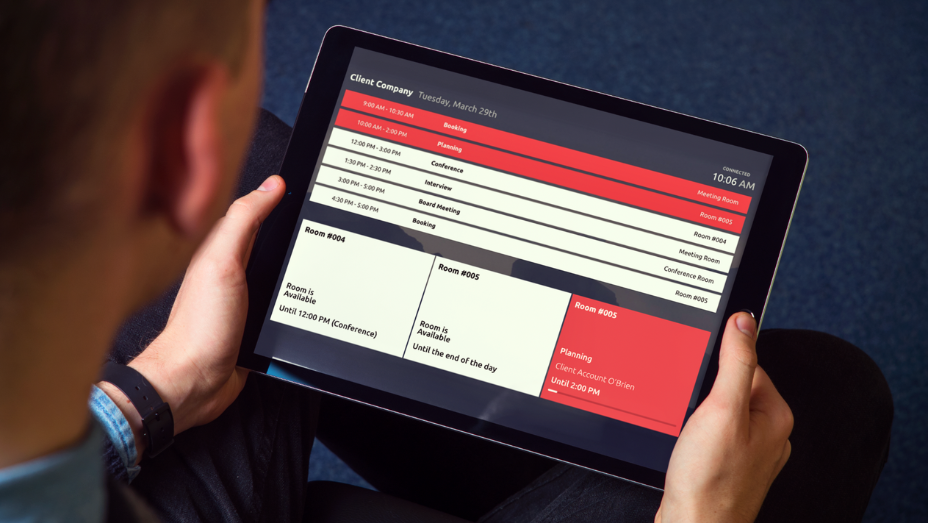
An innovative YAROOMS digital lobby signage application is designed to keep visitors and employees up-to-date with what's happening in your office.
#4: Ensuring Transparent & Autonomous Hybrid Work Planning
Hybrid work planning represents a significant shift towards more flexible, employee-centric work models. It highlights the evolution of workplace innovation in response to changing needs and technologies. Autonomy and transparency are fundamental here, as they allow employees to tailor their work schedules and locations to better suit their personal and professional lives.
By leveraging digital hybrid work planning calendars, such as one offered by YAROOMS, employees can easily align their in-office/work-from-home schedules and quickly identify optimal times for meetings and collaborative sessions. As a result, hybrid work planning not only supports individual flexibility but also promotes a more integrated and cohesive approach to team collaboration, ensuring that projects move forward smoothly and efficiently.
Recent data supports this approach: remote employees (29%) are more engaged than those in hybrid (21%) or fully on-site (20%) arrangements. Additionally, 75% of employees consider the ability to work flexibly critical for their engagement.
#5: Creating a Data-Driven Sustainability Culture
Sustainability culture in the workplace embodies the intersection of innovation and corporate responsibility. By leveraging data analytics, companies can systematically measure their environmental impact, from carbon emissions to resource consumption, and make informed decisions to optimize.
Embedding a data-driven sustainability culture within the workplace catalyzes broader organizational change, influencing everything from procurement policies to product design and operational processes. It empowers companies to set clear, measurable targets and track real-time progress. This not only enhances brand reputation and meets increasing consumer demands for responsible business practices but also leads to cost savings through efficient resource use and waste reduction.
Ultimately, by prioritizing data-driven sustainability, businesses can achieve a competitive edge, drive innovation, and play a pivotal role in addressing the global environmental challenges of our time. No surprise why 39% of CEOs report that increasing R&D funding for sustainable innovation is crucial!
#6: Implementing Employee-Centered Workplace Technology
Workplace technology that is genuinely innovative focuses on being employee-centered because it prioritizes enhancing the overall work experience, boosting productivity, and meeting the workforce's unique needs. When technology solutions are designed with the end-user in mind, they are more likely to be adopted smoothly, used effectively, and contribute to job satisfaction and engagement.
The employee-centered approach encourages a culture of innovation where employees feel supported by technology that acknowledges their challenges and aids in their professional development. By centering technology around the employees, organizations can foster a more dynamic, inclusive, and efficient workplace environment, leading to better business outcomes and a competitive edge in their industry.
#7: Integrating Artificial Intelligence and Machine Learning
Artificial Intelligence (AI) and Machine Learning (ML) are the most talked-about examples of workplace innovation today. By automating routine tasks, AI and ML technologies enhance efficiency and free up employees to focus on more complex, creative, and strategic work.
Organizations using AI tools reported up to 30% better HR team performance, while AI adoption enabled HR teams to be 30% more effective overall. According to recent projections, automation of strategic planning and execution activities is expected to increase from 15% to 50% by 2026, highlighting the growing importance of AI-driven workplace innovations.

#8: Implementing Idea Management Systems
Idea management systems represent a systematic approach to capturing, evaluating, and implementing employee suggestions. These digital platforms allow staff at all levels to submit ideas for improvements, innovations, or solutions to specific challenges. By democratizing the innovation process, organizations can tap into the collective intelligence of their entire workforce rather than relying solely on designated innovation teams.
#9: Organizing Innovation Challenges and Hackathons
Innovation challenges and hackathons provide focused opportunities for employees to collaborate intensively on solving specific business problems or developing new ideas within a limited timeframe. These events break down hierarchical barriers and departmental silos, encouraging cross-functional collaboration and rapid prototyping.
#10: Establishing Innovation Labs or Incubators
Innovation labs or incubators provide dedicated physical or virtual spaces where employees can experiment with new technologies, processes, or business models outside the constraints of day-to-day operations. These environments are specifically designed to foster creativity and support the development of ideas that might be too risky or disruptive for immediate implementation in the core business.
For example, Hanseatic Bank launched an Open Banking Innovation Lab to explore API-driven financial services, leveraging cloud infrastructure and cross-functional collaboration. The lab played a key role in accelerating their digital transformation while ensuring data security and regulatory compliance.
#11: Implementing Cross-Functional Rotational Programs
Cross-functional rotational programs allow employees to temporarily work in different departments or roles throughout the organization. This innovative approach to talent development provides staff with a broader organizational perspective, diverse skill sets, and expanded professional networks.
One company that adopted such an approach launched a “Skill Exchange” program, enabling employees to rotate through areas like engineering, sales, and customer service. The initiative not only boosted job satisfaction but also led to a 34% increase in process improvement suggestions, including a product design change that significantly reduced customer complaints and warranty costs.
#12: Adopting Design Thinking Methodologies
Design thinking represents a human-centered approach to innovation that draws from the designer's toolkit to integrate human needs, technological possibilities, and business requirements. Emphasizing empathy, creative problem framing, and rapid prototyping, this methodology has been successfully applied in contexts like healthcare, where a regional network reimagined the patient journey by involving both staff and patients in identifying pain points and testing new service models. The initiative led to a 32% increase in patient satisfaction and an 18-minute reduction in wait times, while also uncovering unexpected insights—such as the importance patients placed on clear communication during delays.
Implementation Framework for Workplace Innovation
Creating a successful innovation culture requires more than just encouraging creative thinking. Organizations need a structured approach to systematically implement and sustain innovation initiatives. Here's a practical framework for building innovation capabilities:
Step 1: Assess Your Current Innovation Readiness
Begin by evaluating your organization's existing innovation capacity and identifying gaps. Consider factors like leadership support, resource availability, organizational structure, and employee skills. Use surveys, interviews, and workshops to gather insights about barriers to innovation and areas of opportunity.
Key activities include:
- Conducting an innovation audit to benchmark current practices
- Identifying cultural elements that support or hinder innovation
- Evaluating existing processes for idea generation and implementation
- Assessing leadership commitment to innovation initiatives

Step 2: Develop a Clear Innovation Strategy
Define what innovation means for your organization and how it connects to broader business objectives. An effective innovation strategy establishes focus areas, allocates resources appropriately, and creates alignment across the organization.
Your innovation strategy should address:
- Specific innovation goals and priorities
- Balance between incremental and disruptive innovation
- Resource allocation and funding mechanisms
- Timeline for implementation and expected outcomes
Step 3: Build Innovation Capabilities
Systematically develop the skills, processes, and tools needed to support innovation. This includes training programs, collaboration platforms, and methodologies for idea management.
Key capability-building activities include:
- Conducting innovation training for employees at all levels
- Establishing idea management systems and processes
- Creating physical and digital spaces for collaboration
- Developing innovation metrics and measurement frameworks
Step 4: Create Supportive Governance Structures
Implement governance mechanisms that balance guidance with autonomy. Effective innovation governance clarifies decision-making processes, funding pathways, and how innovations move from concept to implementation.
Essential governance elements include:
- Innovation steering committee with cross-functional representation
- Clear criteria for evaluating and prioritizing ideas
- Stage-gate process for advancing promising innovations
- Mechanisms for allocating resources to innovation projects
Step 5: Foster a Culture of Innovation
Culture is perhaps the most critical element of sustainable innovation. Build an environment where experimentation is encouraged, failure is viewed as learning, and diverse perspectives are valued.
Effective culture-building strategies include:
- Recognizing and rewarding innovative behaviors and contributions
- Encouraging reasonable risk-taking and learning from failures
- Creating opportunities for cross-functional collaboration
- Ensuring leaders model innovative behaviors and mindsets
Step 6: Implement, Measure, and Iterate
Launch innovation initiatives with clear metrics for success, gather feedback continuously, and refine your approach based on results. Innovation is not a one-time project but an ongoing capability that requires continuous improvement.
This step includes:
- Implementing pilot projects to test new approaches
- Measuring both process metrics (e.g., number of ideas) and outcome metrics (e.g., revenue from new offerings)
- Gathering feedback from participants and stakeholders
- Regularly reviewing and refining innovation processes
By following this structured framework, organizations can move beyond ad-hoc innovation efforts toward a systematic approach that delivers sustainable results. The most successful innovators recognize that building innovation capability is a journey that requires patience, persistence, and continuous learning.

Industry-Specific Innovation Trends
Different industries face unique challenges and opportunities when implementing workplace innovations. Understanding these sector-specific trends can help organizations develop more targeted innovation strategies that address their particular context and needs.
Healthcare Innovation Trends
The healthcare sector is experiencing rapid transformation driven by several key innovations:
AI and Automation Adoption Healthcare organizations are increasingly implementing AI solutions to enhance operational efficiency and reduce administrative burdens. According to recent data, 85% of healthcare organizations are expected to use AI by 2025. Particularly promising applications include:
- Ambient listening technology for clinical documentation
- AI-powered virtual nursing programs
- Computer vision solutions for patient monitoring
Remote Patient Monitoring and Wearables The expansion of hospital-at-home programs represents a significant innovation in care delivery models. These programs are increasingly integrating remote monitoring technologies and wearables for continuous patient data collection, enabling more proactive and personalized care approaches.
Implementation Approach: Healthcare organizations are taking a measured, outcomes-focused approach to innovation. Rather than implementing technology broadly, successful innovators in this space identify specific use cases with clear clinical or operational benefits. Success metrics typically include improved clinical efficiency, reduced administrative burden, enhanced patient care quality, and regulatory compliance.
Manufacturing Innovation Trends
Manufacturing is undergoing a technological renaissance with several key innovation areas:
Advanced Automation and Robotics Manufacturers are increasingly adopting collaborative robots (cobots) and AI-driven predictive maintenance systems. These technologies are transforming production environments by enhancing safety, improving quality control, and increasing operational efficiency.
Digital Twins and Simulation The adoption of digital twin technology—virtual replicas of physical assets, processes, or systems—is revolutionizing manufacturing operations. These tools enable:
- Enhanced training programs
- Process optimization without disrupting production
- Predictive analytics for maintenance and quality control
Implementation Approach: Manufacturing companies typically approach innovation as part of broader digital transformation strategies, with a clear focus on ROI and practical applications. Technology investments by manufacturing companies accounted for 30% of their operating budget in 2024, up from 23% in 2023. Success metrics include increased operational efficiency, reduced downtime, improved decision-making, and enhanced product quality.
Financial Services Innovation Trends
The financial services sector is navigating disruption through several key innovation areas:
AI-Driven Automation Financial institutions are rapidly adopting AI to enhance operational efficiency across multiple functions. This technology has the potential to increase global banking profits by 9% by 2028. Key applications include:
- Payment processing automation
- Risk assessment and fraud detection
- Customer service enhancement
Blockchain and Cryptocurrency Integration Financial services firms are increasingly exploring blockchain technology for applications beyond cryptocurrency, including supply chain transparency, transaction verification, and secure data sharing.
Sustainable Investing Solutions Growing focus on Environmental, Social, and Governance (ESG) factors is driving innovation in investment products, risk assessment methodologies, and reporting tools.
Implementation Approach: Financial institutions typically balance innovation with regulatory compliance, focusing on use cases that enhance efficiency without compromising security or customer trust. Success metrics include cost reduction, improved customer experience, enhanced risk management capabilities, and regulatory compliance.
Key Cross-Industry Differences
When implementing workplace innovations, organizations should consider these important industry distinctions:
- Regulatory Environment: Healthcare and financial services face stricter regulations than manufacturing, affecting innovation speed and scope.
- Data Sensitivity: Healthcare and financial services handle highly sensitive personal data, requiring more robust security measures.
- Customer Interaction: Financial services and healthcare prioritize innovations enhancing customer/patient experience, while manufacturing focuses more on operational efficiency.
- Workforce Impact: Manufacturing emphasizes technologies that augment human workers, while healthcare and financial services focus on reducing administrative burdens.
- Implementation Speed: Manufacturing typically implements new technologies faster due to fewer regulatory hurdles compared to healthcare and financial services.
Understanding these industry-specific contexts can help organizations develop more effective, targeted innovation strategies that address their particular challenges and opportunities.

Overcoming Barriers to Implementing Workplace Innovation
The desire to innovate is one thing; excelling in its implementation is another. A McKinsey survey found that 80 or 90 percent of executives say innovation is a top priority, but only 6 percent are satisfied with their innovation performance. According to another study by NTT DATA, only 21% of organizations achieve their innovation goals.
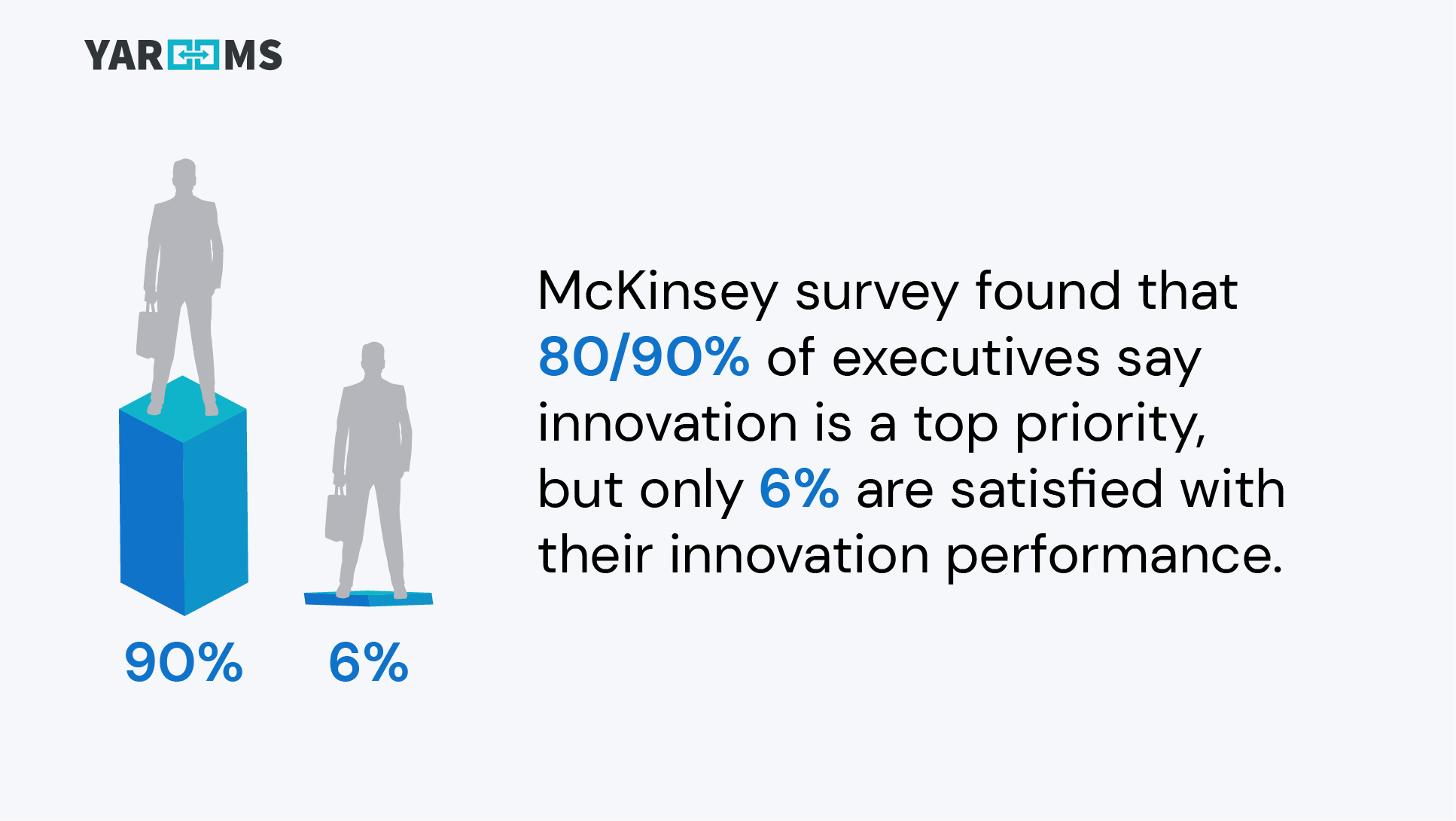
When driving for innovation in the workplace, it's inevitable to encounter obstacles. Here are the five most common barriers and proven strategies to overcome them:
1. Lack of Innovation Culture
Many organizations struggle to foster a culture that truly embraces innovation and risk-taking.
Effective strategies:
- Create dedicated innovation time: Google's "20% time" policy allows employees to spend 20% of their work time on personal projects, which led to the creation of Gmail and Google News
- Encourage experimentation: Foster an environment where calculated risks are accepted and failures are viewed as learning opportunities
- Recognize and reward innovation: Westin Hotels sends its top five innovators on a paid five-day trip each quarter to publicly acknowledge valuable ideas
2. Resistance to Change
Employees and leaders may resist new ideas due to fear of failure or attachment to existing methods.
Effective strategies:
- Communicate benefits clearly: Explain how innovation aligns with company goals and benefits employees
- Involve employees in the process: Solicit feedback and ideas from staff to create buy-in and ownership
- Address underlying fears: Provide training and support to help employees adapt to changes
3. Lack of Resources and Budget
Insufficient funding, time, or expertise can hinder innovation efforts.
Effective strategies:
- Start small: Begin with a few well-defined projects to demonstrate value before expanding
- Leverage existing resources: Encourage cross-functional collaboration to utilize diverse skills and perspectives
- Implement stage-gate funding: Fund ideas at each development stage to ensure resources are used efficiently
4. Poor Communication and Collaboration
Silos and ineffective information sharing can stifle innovation.
Effective strategies:
- Create transparent idea management systems: Give employees visibility into the innovation process and implementation of ideas
- Hold regular brainstorming sessions: Conduct cross-functional meetings to generate ideas and discuss ongoing projects
- Use collaboration tools: Implement software that facilitates idea sharing and tracking across the organization
5. Lack of Clear Strategy and Leadership Support
Without a defined innovation strategy and executive buy-in, efforts can become unfocused and unsupported.
Effective strategies:
- Develop a clear innovation strategy: Define specific goals, KPIs, and processes for innovation initiatives
- Secure executive sponsorship: Ensure leadership actively supports and participates in innovation efforts
- Align innovation with company objectives: Demonstrate how innovation projects contribute to overall business goals
According to recent data, 70% of employees who fear AI will replace their job are considering or actively looking for new employment. This highlights how innovation without proper change management and communication can create unintended consequences, underscoring the importance of addressing these barriers systematically.
Measuring the Success of Workplace Innovations
Measuring innovation success is vital in any workplace, beyond launching new ideas to ensuring they genuinely contribute to organizational growth. Effective measurement requires comprehensive frameworks that capture both tangible and intangible benefits of innovation initiatives. Here are several proven approaches to evaluating innovation success:
Balanced Scorecard Approach
This framework categorizes innovation KPIs into four perspectives:
- Financial: Percentage of revenue from new products launched within the last 3 years, return on innovation investment
- Customer: Customer satisfaction scores related to innovations, adoption rates of new offerings
- Internal processes: Time-to-market for new features, idea implementation rate
- Learning and growth: Employee engagement in innovation activities, skills development
Industry example: Philips uses this approach and reported a 30% increase in overall revenue by tracking metrics like percentage of revenue from new products.

Input-Process-Output Framework
This methodology measures innovation across three categories:
Input Metrics:
- R&D budget as percentage of revenue
- Number of employees dedicated to innovation
- Hours of employee time allocated to innovation
Process Metrics:
- Idea generation rate
- Percentage of ideas progressing to experimentation
- Time from idea to prototype
Output Metrics:
- Number of new products launched
- Revenue generated from new products/services
- Market share gains from innovations
Industry example: 3M uses this framework to enable past success to inform future innovation efforts.
Four Types of Innovation Metrics
This approach categorizes metrics into:
Financial Returns:
- Cost savings
- Process efficiencies
- Incremental revenues
Productivity Levels:
- Ideation volume
- Projects launched
- Engagement levels
Portfolio Health:
- Strategic alignment
- Risk balance
- Resource allocation
Activities Mix:
- Percentage of incremental vs. disruptive projects
- Internal vs. external innovation balance
Industry example: Siemens adopted an "Innovation Quotient" metric aligned with this framework, resulting in €4 billion in new product revenue over 5 years.
Innovation Metrics Framework
This methodology focuses on measuring across four stages:
Problem/Solution Fit:
- Customer problem validation
- Solution concept validation
Product/Market Fit:
- Minimum viable product (MVP) validation
- Business model validation
Scale:
- Growth rate
- Unit economics
Profit:
- Profitability
- Return on investment
Industry example: Dropbox used this approach, starting with an MVP to validate product-market fit before scaling to over 500 million users.
When implementing measurement frameworks, balance quantitative metrics with qualitative insights. The most effective innovation measurement systems evolve as your innovation capabilities mature, starting with simple metrics focused on activities and gradually incorporating more sophisticated outcome measures as your innovation processes become more established.
Frequently Asked Questions about Implementing Workplace Innovation
Implementing innovation in the workplace often raises important questions about execution, challenges, and best practices. Here are answers to the most common questions organizations face when building innovative cultures:
What Qualifies as 'Innovation' in a Company?
Innovation encompasses more than novel ideas; it includes any new practices, processes, or tools that transform existing paradigms. This could involve technological implementations, communication channels, sustainable practices, or workspace designs. True innovation delivers tangible value by solving problems, improving efficiency, enhancing customer experiences, or creating new market opportunities.

Why Should My Business Invest in Workplace Innovation?
Organizations that prioritize innovation consistently outperform their peers. According to recent data, companies with high employee engagement in innovation efforts are 21% more profitable than competitors. Innovation drives improvement across multiple dimensions, including productivity, efficiency, employee retention, and market differentiation. It also helps organizations adapt to changing market conditions and customer preferences, ensuring long-term sustainability.
How Do We Fund Innovation Initiatives with Limited Resources?
Limited resources needn't constrain innovation. Consider these approaches:
- Start with small, focused experiments that require minimal investment
- Implement stage-gate funding models that allocate resources incrementally based on proven results
- Repurpose a small percentage of existing budgets across departments for innovation initiatives
- Explore innovation partnerships with suppliers, customers, or academic institutions to share costs and risks
- Focus initially on efficiency innovations that generate savings to fund future growth-oriented innovations
How Can We Overcome Resistance to Innovation?
Resistance often stems from fear, uncertainty, or misalignment. Address these concerns by:
- Communicating the purpose and expected benefits of innovation initiatives clearly
- Involving potential resistors early in the process to incorporate their perspectives and build ownership
- Providing adequate training and support to help employees develop necessary skills
- Celebrating early wins to demonstrate the value of new approaches
- Acknowledging and addressing legitimate concerns rather than dismissing them
What Metrics Should We Use to Measure Innovation Success?
Effective innovation measurement combines leading indicators (activity metrics) and lagging indicators (outcome metrics). Consider measuring:
- Input metrics: Resources allocated to innovation, employee participation rates
- Process metrics: Number of ideas generated, implementation rate, cycle time from idea to execution
- Output metrics: Revenue from new offerings, cost savings from process improvements, customer adoption rates
- Impact metrics: Market share changes, employee engagement scores, brand perception improvements
Choose metrics aligned with your specific innovation goals and organizational context, and adjust your measurement framework as your innovation capabilities mature.
-
The most successful organizations approach innovation systematically rather than treating it as a series of isolated initiatives. By creating the right conditions—a supportive culture, clear processes, appropriate resources, and meaningful metrics—any organization can harness the transformative power of workplace innovation to drive growth and create competitive advantage.
What workplace innovations have you implemented in your organization?


